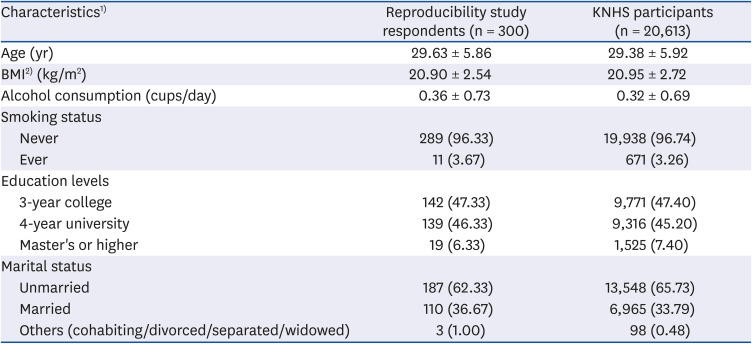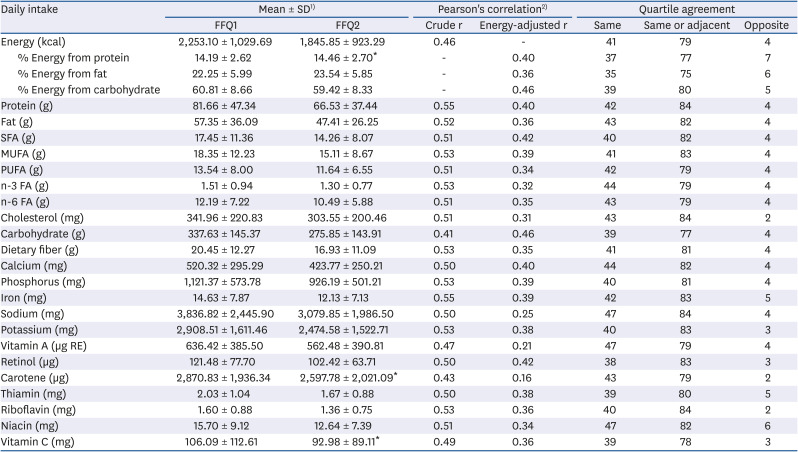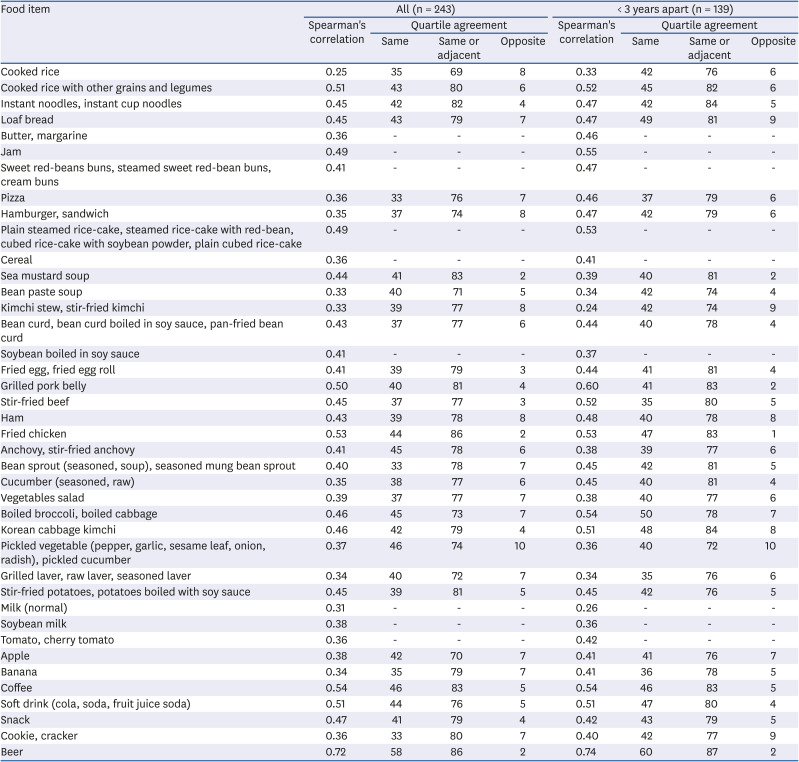1. Peters SA, Woodward M, Jha V, Kennedy S, Norton R. Women's health: a new global agenda. BMJ Glob Health. 2016; 1:e000080.

2. World Health Organization. World Health Statistics 2019: Monitoring Health for the SDGs, Sustainable Development Goals. Geneva: World Health Organization;2019.
3. Colditz GA, Philpott SE, Hankinson SE. The impact of the Nurses' Health Study on population health: prevention, translation, and control. Am J Public Health. 2016; 106:1540–1545. PMID:
27459441.

4. Design of the Women's Health Initiative clinical trial and observational study. The Women's Health Initiative Study Group. Control Clin Trials. 1998; 19:61–109. PMID:
9492970.
5. Zheng W, Chow WH, Yang G, Jin F, Rothman N, Blair A, Li HL, Wen W, Ji BT, Li Q, et al. The Shanghai Women's Health Study: rationale, study design, and baseline characteristics. Am J Epidemiol. 2005; 162:1123–1131. PMID:
16236996.

6. Folsom AR, Kushi LH, Anderson KE, Mink PJ, Olson JE, Hong CP, Sellers TA, Lazovich D, Prineas RJ. Associations of general and abdominal obesity with multiple health outcomes in older women: the Iowa Women's Health Study. Arch Intern Med. 2000; 160:2117–2128. PMID:
10904454.
7. Darnton-Hill I, Nishida C, James WP. A life course approach to diet, nutrition and the prevention of chronic diseases. Public Health Nutr. 2004; 7:101–121. PMID:
14972056.

8. Barker DJ. Maternal nutrition, fetal nutrition, and disease in later life. Nutrition. 1997; 13:807–813. PMID:
9290095.

9. Willett W. Nutritional Epidemiology. New York (NY): Oxford University Press;2012.
10. Hu FB, Satija A, Rimm EB, Spiegelman D, Sampson L, Rosner B, Camargo CA Jr, Stampfer M, Willett WC. Diet assessment methods in the Nurses' Health Studies and contribution to evidence-based nutritional policies and guidelines. Am J Public Health. 2016; 106:1567–1572. PMID:
27459459.

11. Yu E, Rimm E, Qi L, Rexrode K, Albert CM, Sun Q, Willett WC, Hu FB, Manson JE. Diet, lifestyle, biomarkers, genetic factors, and risk of cardiovascular disease in the Nurses' Health Studies. Am J Public Health. 2016; 106:1616–1623. PMID:
27459449.

12. Kim O, Ahn Y, Lee HY, Jang HJ, Kim S, Lee JE, Jung H, Cho E, Lim JY, Kim MJ, et al. The Korea Nurses' Health Study: a prospective cohort study. J Womens Health (Larchmt). 2017; 26:892–899. PMID:
28771383.

13. Yun SH, Shim JS, Kweon S, Oh K. Development of a food frequency questionnaire for the Korea National Health and Nutrition Examination Survey: data from the fourth Korea National Health and Nutrition Examination Survey (KNHANES IV). Korean J Nutr. 2013; 46:186–196.

14. Kim DW, Song S, Lee JE, Oh K, Shim J, Kweon S, Paik HY, Joung H. Reproducibility and validity of an FFQ developed for the Korea National Health and Nutrition Examination Survey (KNHANES). Public Health Nutr. 2015; 18:1369–1377. PMID:
25167205.

15. Kim Y, Je Y. Moderate coffee consumption is inversely associated with the metabolic syndrome in the Korean adult population. Br J Nutr. 2018; 120:1279–1287. PMID:
30311595.

16. Kim Y, Je Y. A modified Mediterranean diet score is inversely associated with metabolic syndrome in Korean adults. Eur J Clin Nutr. 2018; 72:1682–1689. PMID:
29563642.

17. Shin S, Kim SA, Ha J, Lim K. Sugar-sweetened beverage consumption in relation to obesity and metabolic syndrome among Korean adults: a cross-sectional study from the 2012–2016 Korean national health and nutrition examination survey (KNHANES). Nutrients. 2018; 10:1467.

18. Choi A, Ha K, Joung H, Song Y. Frequency of consumption of whole fruit, not fruit juice, is associated with reduced prevalence of obesity in Korean adults. J Acad Nutr Diet. 2019; 119:1842–1851.e2. PMID:
31262696.

19. Kim H, Lee K, Rebholz CM, Kim J. Association between unhealthy plant-based diets and the metabolic syndrome in adult men and women: a population-based study in South Korea. Br J Nutr. 2021; 125:1–14. PMID:
31685042.

20. Bao Y, Bertoia ML, Lenart EB, Stampfer MJ, Willett WC, Speizer FE, Chavarro JE. Origin, methods, and evolution of the three Nurses' Health Studies. Am J Public Health. 2016; 106:1573–1581. PMID:
27459450.

21. Korea Disease Control and Prevention Agency. Nutrient Database for Food Frequency Questionnaire in the Korea National Health and Nutrition Examination Survey. Cheongju: Korea Disease Control and Prevention Agency;2015.
22. Ahn Y, Kwon E, Shim JE, Park MK, Joo Y, Kimm K, Park C, Kim DH. Validation and reproducibility of food frequency questionnaire for Korean genome epidemiologic study. Eur J Clin Nutr. 2007; 61:1435–1441. PMID:
17299477.

23. Park MK, Noh HY, Song NY, Paik HY, Park S, Joung H, Song WO, Kim J. Validity and reliability of a dish-based, semi-quantitative food frequency questionnaire for Korean diet and cancer research. Asian Pac J Cancer Prev. 2012; 13:545–552. PMID:
22524822.

24. Bae YJ, Choi HY, Sung MK, Kim MK, Choi MK. Validity and reproducibility of a food frequency questionnaire to assess dietary nutrients for prevention and management of metabolic syndrome in Korea. Nutr Res Pract. 2010; 4:121–127. PMID:
20461200.

25. Imaeda N, Fujiwara N, Tokudome Y, Ikeda M, Kuriki K, Nagaya T, Sato J, Goto C, Maki S, Tokudome S. Reproducibility of a semi-quantitative food frequency questionnaire in Japanese female dietitians. J Epidemiol. 2002; 12:45–53. PMID:
11848184.

26. Ishihara J, Sobue T, Yamamoto S, Yoshimi I, Sasaki S, Kobayashi M, Takahashi T, Iitoi Y, Akabane M, Tsugane S, et al. Validity and reproducibility of a self-administered food frequency questionnaire in the JPHC Study Cohort II: study design, participant profile and results in comparison with Cohort I. J Epidemiol. 2003; 13:S134–S147. PMID:
12701641.

27. Tsubono Y, Kobayashi M, Sasaki S, Tsugane S; JPHC. Validity and reproducibility of a self-administered food frequency questionnaire used in the baseline survey of the JPHC Study Cohort I. J Epidemiol. 2003; 13:S125–S133. PMID:
12701640.

28. Franceschi S, Barbone F, Negri E, Decarli A, Ferraroni M, Filiberti R, Giacosa A, Gnagnarella P, Nanni O, Salvini S, et al. Reproducibility of an Italian food frequency questionnaire for cancer studies. Results for specific nutrients. Ann Epidemiol. 1995; 5:69–75. PMID:
7728288.
29. Riboli E, Toniolo P, Kaaks R, Shore RE, Casagrande C, Pasternack BS. Reproducibility of a food frequency questionnaire used in the New York University Women’s Health Study: effect of self-selection by study subjects. Eur J Clin Nutr. 1997; 51:437–442. PMID:
9234025.

30. Bohlscheid-Thomas S, Hoting I, Boeing H, Wahrendorf J. Reproducibility and relative validity of energy and macronutrient intake of a food frequency questionnaire developed for the German part of the EPIC project. European Prospective Investigation into Cancer and Nutrition. Int J Epidemiol. 1997; 26(Suppl 1):S71–S81. PMID:
9126535.

31. Goldbohm RA, van't Veer P, van den Brandt PA, van’t Hof MA, Brants HA, Sturmans F, Hermus RJ. Reproducibility of a food frequency questionnaire and stability of dietary habits determined from five annually repeated measurements. Eur J Clin Nutr. 1995; 49:420–429. PMID:
7656885.
32. Tsubono Y, Nishino Y, Fukao A, Hisamichi S, Tsugane S. Temporal change in the reproducibility of a self-administered food frequency questionnaire. Am J Epidemiol. 1995; 142:1231–1235. PMID:
7485070.

33. Pisani P, Faggiano F, Krogh V, Palli D, Vineis P, Berrino F. Relative validity and reproducibility of a food frequency dietary questionnaire for use in the Italian EPIC centres. Int J Epidemiol. 1997; 26(Suppl 1):S152–S160. PMID:
9126543.

34. Willett WC, Sampson L, Browne ML, Stampfer MJ, Rosner B, Hennekens CH, Speizer FE. The use of a self-administered questionnaire to assess diet four years in the past. Am J Epidemiol. 1988; 127:188–199. PMID:
3337073.

35. Nagel G, Zoller D, Ruf T, Rohrmann S, Linseisen J. Long-term reproducibility of a food-frequency questionnaire and dietary changes in the European Prospective Investigation into Cancer and Nutrition (EPIC)-Heidelberg cohort. Br J Nutr. 2007; 98:194–200. PMID:
17367573.

36. Lee Y, Park K. Reproducibility and validity of a semi-quantitative FFQ for trace elements. Br J Nutr. 2016; 116:864–873. PMID:
27378401.

37. Willett WC, Sampson L, Stampfer MJ, Rosner B, Bain C, Witschi J, Hennekens CH, Speizer FE. Reproducibility and validity of a semiquantitative food frequency questionnaire. Am J Epidemiol. 1985; 122:51–65. PMID:
4014201.

38. Colditz GA, Willett WC, Stampfer MJ, Sampson L, Rosner B, Hennekens CH, Speizer FE. The influence of age, relative weight, smoking, and alcohol intake on the reproducibility of a dietary questionnaire. Int J Epidemiol. 1987; 16:392–398. PMID:
3667037.

39. Munger RG, Folsom AR, Kushi LH, Kaye SA, Sellers TA. Dietary assessment of older Iowa women with a food frequency questionnaire: nutrient intake, reproducibility, and comparison with 24-hour dietary recall interviews. Am J Epidemiol. 1992; 136:192–200. PMID:
1415141.

40. Martin-Moreno JM, Boyle P, Gorgojo L, Maisonneuve P, Fernandez-Rodriguez JC, Salvini S, Willett WC. Development and validation of a food frequency questionnaire in Spain. Int J Epidemiol. 1993; 22:512–519. PMID:
8359969.

41. Männistö S, Virtanen M, Mikkonen T, Pietinen P. Reproducibility and validity of a food frequency questionnaire in a case-control study on breast cancer. J Clin Epidemiol. 1996; 49:401–409. PMID:
8621990.

42. Xing X, Burr JA, Brasure JR, Neugut AI, Marshall JR. Reproducibility of nutrient intake in a food frequency questionnaire used in a general population. Nutr Cancer. 1996; 25:259–268. PMID:
8771569.

43. Katsouyanni K, Rimm EB, Gnardellis C, Trichopoulos D, Polychronopoulos E, Trichopoulou A. Reproducibility and relative validity of an extensive semi-quantitative food frequency questionnaire using dietary records and biochemical markers among Greek schoolteachers. Int J Epidemiol. 1997; 26(Suppl 1):S118–S127. PMID:
9126540.

44. Ocké MC, Bueno-de-Mesquita HB, Pols MA, Smit HA, van Staveren WA, Kromhout D. The Dutch EPIC food frequency questionnaire. II. Relative validity and reproducibility for nutrients. Int J Epidemiol. 1997; 26(Suppl 1):S49–S58. PMID:
9126533.
45. Romieu I, Parra S, Hernández JF, Madrigal H, Willett W, Hernández M. Questionnaire assessment of antioxidants and retinol intakes in Mexican women. Arch Med Res. 1999; 30:224–239. PMID:
10427874.

46. Shu XO, Yang G, Jin F, Liu D, Kushi L, Wen W, Gao YT, Zheng W. Validity and reproducibility of the food frequency questionnaire used in the Shanghai Women's Health Study. Eur J Clin Nutr. 2004; 58:17–23. PMID:
14679362.

47. Parr CL, Veierød MB, Laake P, Lund E, Hjartåker A. Test-retest reproducibility of a food frequency questionnaire (FFQ) and estimated effects on disease risk in the Norwegian Women and Cancer Study (NOWAC). Nutr J. 2006; 5:4. PMID:
16448553.

48. Horn-Ross PL, Lee VS, Collins CN, Stewart SL, Canchola AJ, Lee MM, Reynolds P, Clarke CA, Bernstein L, Stram DO. Dietary assessment in the California Teachers Study: reproducibility and validity. Cancer Causes Control. 2008; 19:595–603. PMID:
18256894.

49. Mirmiran P, Esfahani FH, Mehrabi Y, Hedayati M, Azizi F. Reliability and relative validity of an FFQ for nutrients in the Tehran lipid and glucose study. Public Health Nutr. 2010; 13:654–662. PMID:
19807937.

50. Xing X, Burr JA, Brasure JR, Neugut AI, Marshall JR. Reproducibility of food intake in a food frequency questionnaire used in a general population. Nutr Cancer. 1995; 24:85–95. PMID:
7491301.

51. Ocké MC, Bueno-de-Mesquita HB, Goddijn HE, Jansen A, Pols MA, van Staveren WA, Kromhout D. The Dutch EPIC food frequency questionnaire. I. Description of the questionnaire, and relative validity and reproducibility for food groups. Int J Epidemiol. 1997; 26(Suppl 1):S37–S48. PMID:
9126532.
52. Esfahani FH, Asghari G, Mirmiran P, Azizi F. Reproducibility and relative validity of food group intake in a food frequency questionnaire developed for the Tehran Lipid and Glucose Study. J Epidemiol. 2010; 20:150–158. PMID:
20154450.
53. Evans JR, Mathur A. The value of online surveys. Internet Res. 2005; 15:195–219.

54. Wright KB. Researching Internet-based populations: advantages and disadvantages of online survey research, online questionnaire authoring software packages, and web survey services. J Comput Mediat Commun. 2005; 10:JCMC1034.

55. Naska A, Lagiou A, Lagiou P. Dietary assessment methods in epidemiological research: current state of the art and future prospects. F1000 Res. 2017; 6:926.

56. Beasley JM, Davis A, Riley WT. Evaluation of a web-based, pictorial diet history questionnaire. Public Health Nutr. 2009; 12:651–659. PMID:
18547450.

57. González Carrascosa R, García Segovia P, Martínez Monzó J. Paper and pencil vs online self-administered food frequency questionnaire (FFQ) applied to university population: a pilot study. Nutr Hosp. 2011; 26:1378–1384. PMID:
22411386.
58. Lo Siou G, Csizmadi I, Boucher BA, Akawung AK, Whelan HK, Sharma M, Al Rajabi A, Vena JE, Kirkpatrick SI, Koushik A, et al. The comparative reliability and feasibility of the past-year Canadian diet history questionnaire II: comparison of the paper and web versions. Nutrients. 2017; 9:133.

59. Zazpe I, Santiago S, De la Fuente-Arrillaga C, Nuñez-Córdoba JM, Bes-Rastrollo M, Martínez-González MA. Paper-based versus web-based versions of self-administered questionnaires, including food-frequency questionnaires: prospective cohort study. JMIR Public Health Surveill. 2019; 5:e11997. PMID:
31573924.

60. Engle A, Lynn LL, Koury K, Boyar AP. Reproducibility and comparability of a computerized, self-administered food frequency questionnaire. Nutr Cancer. 1990; 13:281–292. PMID:
2345706.

61. Labonté ME, Cyr A, Baril-Gravel L, Royer MM, Lamarche B. Validity and reproducibility of a web-based, self-administered food frequency questionnaire. Eur J Clin Nutr. 2012; 66:166–173. PMID:
21934698.

62. Fallaize R, Forster H, Macready AL, Walsh MC, Mathers JC, Brennan L, Gibney ER, Gibney MJ, Lovegrove JA. Online dietary intake estimation: reproducibility and validity of the Food4Me food frequency questionnaire against a 4-day weighed food record. J Med Internet Res. 2014; 16:e190. PMID:
25113936.

63. Kristal AR, Kolar AS, Fisher JL, Plascak JJ, Stumbo PJ, Weiss R, Paskett ED. Evaluation of web-based, self-administered, graphical food frequency questionnaire. J Acad Nutr Diet. 2014; 114:613–621. PMID:
24462267.

64. Marshall SJ, Livingstone KM, Celis-Morales C, Forster H, Fallaize R, O'Donovan CB, Woolhead C, Marsaux CF, Macready AL, Navas-Carretero S, et al. Reproducibility of the online Food4Me food-frequency questionnaire for estimating dietary intakes across Europe. J Nutr. 2016; 146:1068–1075. PMID:
27052541.
65. Matthys C, Pynaert I, De Keyzer W, De Henauw S. Validity and reproducibility of an adolescent web-based food frequency questionnaire. J Am Diet Assoc. 2007; 107:605–610. PMID:
17383266.

66. Filippi AR, Amodio E, Napoli G, Breda J, Bianco A, Jemni M, Censi L, Mammina C, Tabacchi G. The web-based ASSO-food frequency questionnaire for adolescents: relative and absolute reproducibility assessment. Nutr J. 2014; 13:119. PMID:
25518876.

67. Overby NC, Johannesen E, Jensen G, Skjaevesland AK, Haugen M. Test-retest reliability and validity of a web-based food-frequency questionnaire for adolescents aged 13–14 to be used in the Norwegian Mother and Child Cohort Study (MoBa). Food Nutr Res. 2014; 58.








 PDF
PDF Citation
Citation Print
Print



 XML Download
XML Download